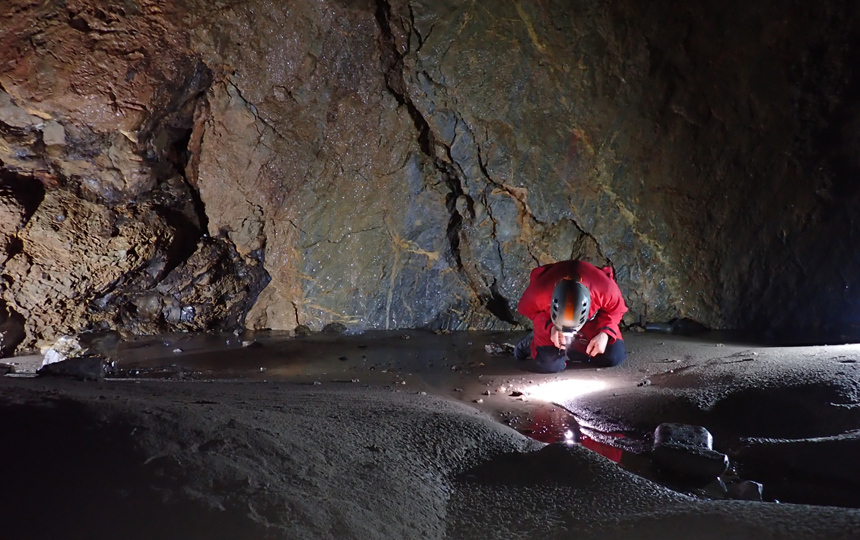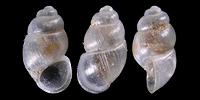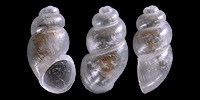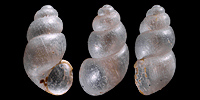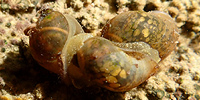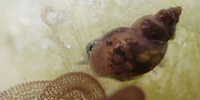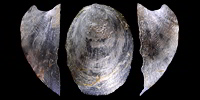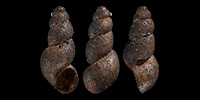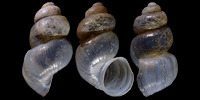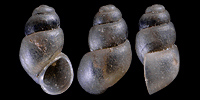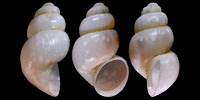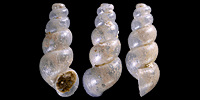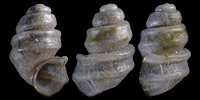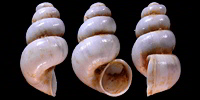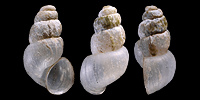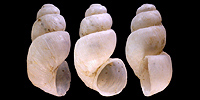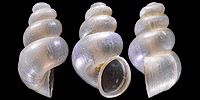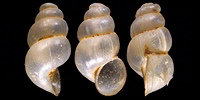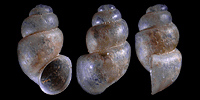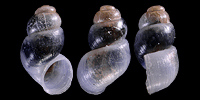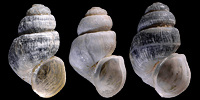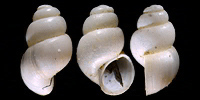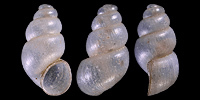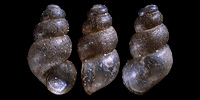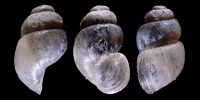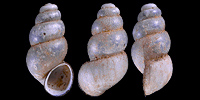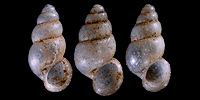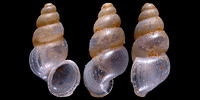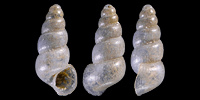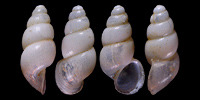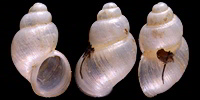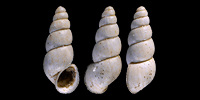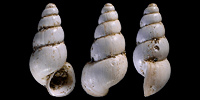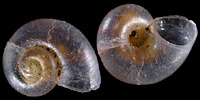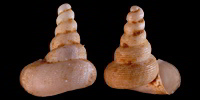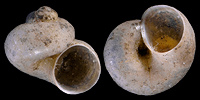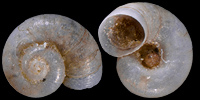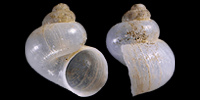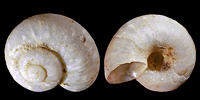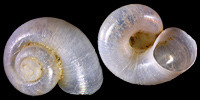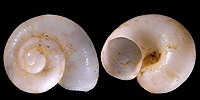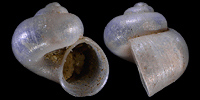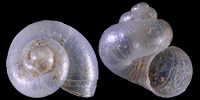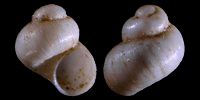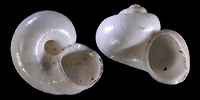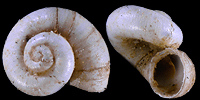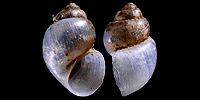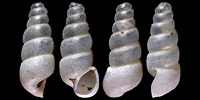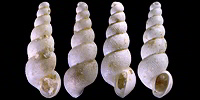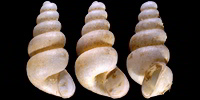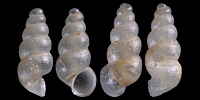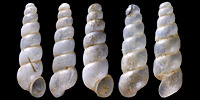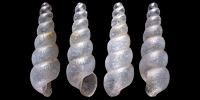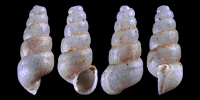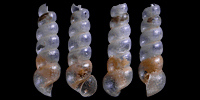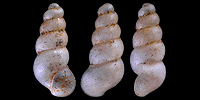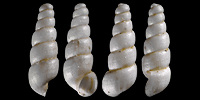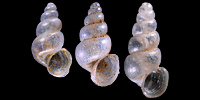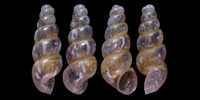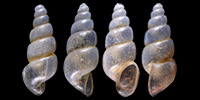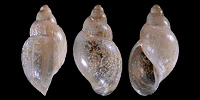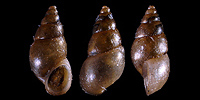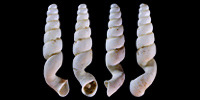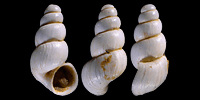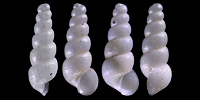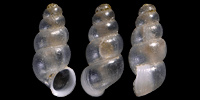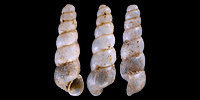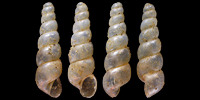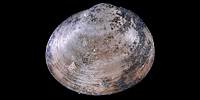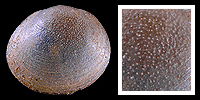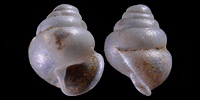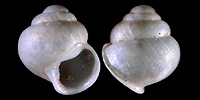| |
| Image by Félix Potuit: Source du Planey (Haute-Saône, France) – Public domain. | |
INDEX |
|
Presentation Plates |
PRESENTATION |
OverviewThese pages are intended to present (as many as possible) species of shelled molluscs that live in the sources and in the cave rivers of the french mainland. Almost all the genera that live occasionaly (stygophile) or exclusively (stygobiont) in underground rivers, or in their springs (crenobiont, thus stygoxen), belong to the Littorinimorpha. In France, less than a hundred of stygobiont species have been described; some of them can be very variable, some are endemic to a single place, some can be found in more than one drainage basin. Each year, new species are discovered. The systematics of these groups present some difficulties. Depending on the authors, most of the gastropods that are found in the springs or in the cave-rivers belong to one family (Hydrobiidæ), two families (Moitessieriidæ, Hydrobiidæ), or three families (Moitessieriidæ, Hydrobiidæ and Amnicolidæ). Regarding the Ancylus fluviatilis described by Müller, which can be found in the twilight zone of some emergences, it is placed sometimes in the family Ancylidæ, sometimes in Planorbidæ. For the species in the genera Bythinella or Islamia, they are almost impossible to identify by their shells alone, except for a few cases. Finally, there are innumerable records of Sphaeriidae (Bivalvia) in the springs as well as in the most remote troughs of mountain pasture; some of these animals have even been found alive in cave-rivers of high altitude (for example at Saint-Vincent river, in La Verna Cavern, western Pyrenees).
The author collecting some sediment at La Verna.
|
 |
PLATESClick on the pics to open the pages. |
GASTROPODA | ||||||
Alzoniella Giusti & Bodon, 1984Crenobiont, often stygobiont. Previously placed in the genus Belgrandiella Wagner, 1928. Shell small, whitish-translucent, conical to cylindrical-conical, with a narrow umbilicus. Three to four body whorls, quite convex, the last one excepted. The apex, rounded, is less obtuse than in the genus Bythinella. | ||||||
Amphipepleinae Pini, 1877In springs, ponds, lakes and streams. It is almost impossible to identify a species after the shell only. For some informations about the taxonomy of radicine snails, see for example Vinarski, Aksenova & Bolotov, 2020. | ||||||
Ancylus O. F. Müller, 1773Shell limpet-shaped, suboval; apex posteriorly placed, somewhat curved; cutaneous respiration. Occasionally encountered in the twilight zone of karst springs. | ||||||
Avenionia Nicolas, 1882« Shell very small, cylindro-conical, bythinelloid, waxen, whitish and translucent when fresh; apex rather acute; spire consisting of 3¾-4¾ convex whorls; last whorl wide, ⅔-¾ of shell height; sutures very deep; aperture rather small, oval and slightly oblique; peristome thin, continuous, adhering to last whorl or slightly detached, not reflected and not sinuous, but sometimes very slightly concave (in lateral view) at upper external margin; umbilicus variably narrow, slit-like; surface of protoconch finely malleated; surface of teleoconch rather smooth, with more or less evident growth lines and very finely malleated on the first whorls. […] Operculum corneous, paucispiral, thin, pale yellowish in colour, yellowish orange at centre, with subcentral nucleus and without projection or thickening on inner side. » – Bodon, Cianfanelli, Manganelli, Girardi &Giusti: “The genus Avenionia Nicolas, 1882, redefined (Gastropoda, Prosobranchia, Hydrobiidae)”, Basteria vol. 64, Leiden 2000, p.188. In freshwater karst springs and hiporheic environments… | ||||||
Belgrandia Wagner, 1928Randomly scattered lenghtened bumps along the body whorls. These bumps cannot be considered as some thickenings of the shell, but as actual bulges. The main differences with the members of the genus Bythinella, in which are found also species with axial bumps on their shells, are anatomical, but the shells of Belgrandia differ also from those of Bythinella by their less obtuse apices. The whorls are more rounded than in Alzoniella. No spiral sculpture. Occasionally encountered in the twilight zone of karst springs. | ||||||
Belgrandiella Wagner, 1928The differences with Belgrandia are mostly anatomical; regarding the morphology, the shells of this genus do not bear axial bumps. Occasionally encountered in the twilight zone of karst springs. | ||||||
Bythinella Moquin-Tandon, 1856Shell smooth, ovoid to conical, with an obtuse apex. The shapes can vary considerably within a same population, and the variation-ranges often overlap between species, making this group very difficult to identify without anatomical studies. The genus can be stygoxen, stygophile, and sometimes stygobiont. Distribution: almost everywhere, as soon as there is a spring. About 80 species in Europe, where live all the members of this genus. The geographical core of the distribution seems to be located in southern France, mostly in the central part of the Pyrenées mountains. | ||||||
Bythiospeum Bourguignat, 1882Stygobiont. Conical to cylindrical shell. Sculpture made up of radial growth marks and, sometimes, obsolete spiral threads. Cf. J. R. Bourguignat: Bythiospeum ou Description d’un nouveau genre de mollusques aveugles, Poissy 1882. Distribution: from the Rhin in the north, west to the Côte d’Or, south to Hérault, Var and Durance. | ||||||
Fissuria Bœters, 1981Minute shell, valvatiform shape. Stygobiont. Distribution: underflow of Durance river. Possible spots in Provence, Alpes-maritimes, Gard. | ||||||
Henrigirardia Bœters & Falkner, 2003Stygobiont. Close to the genus Moitessieria. Strongly conical shell, covered with tessellations. Sometimes arched, the spiral of the body whorls widens whith age, giving the shell a large umbilicus. The distribution of this genus is restricted to some spots along the Hérault river eastern bank. | ||||||
Islamia Radoman, 1973Stygobiont. Minute shell, flattened spire. | ||||||
Melanoides Olivier, 1804In the family THIARIDAE Gill, 1871 (1823), the shells of this genus are characterized by their slender, conical shape; the whorls are flat or weakly convex; the apex is acute. Sculpture of thin longitudinal ribs crossed by more marked spirals; aperture drop-shaped. Distribution: tropical warm waters. | ||||||
| < | ||||||
Mercuria Bœters, 1971In running waters of many kinds. Some species are also crenobiont. « Shell ovate-conical with pointed apex, rounded whorls, deep suture and narrowly perforate umbilicus; milky coloured, especially at the base. » – Bœters & Falkner: “The genus Mercuria Boeters, 1971 in France (Gastropoda: Caenogastropoda: Hydrobiidae). West-European Hydrobiidae, Part 13”, Zoosystema vol. 39(2), Paris 2017, p.229. | ||||||
| < | ||||||
Moitessieria Bourguignat, 1863Stygobiont. Cylindrical to conico-cylindrical shell; microsculpture made of spirally arranged tessellations, often quadrangular. Distribution: from the Pyrenees in the south to the Dordogne, Aveyron, Ardèche in the north, east to the Alpes de Haute-Provence. | ||||||
Palacanthilhiopsis Bernasconi, 1988Stygobiont. Large spike on inner face of operculum, wide umbilicus, radial striae. Distribution: Ardèche and Gard. | ||||||
Paladilhia Bourguignat, 1865Stygobiont. Subsutural pleurotomoid split inserted in an angular furrow that gives the peristome an auriform shape. Distribution: Gard, Ardèche, Hérault. | ||||||
Palaospeum Bœters, 1999Stygobiont. Lengthened shell, conical, large, with an almost smooth surface; outer lip and growth marks slightly opisthocline. Distribution: western Pyrenees. | ||||||
Physella Haldeman, 1842In the family PHYSIDAE Fitzinger, 1833 (sinistral coiling, pointed foot, slender tentacles). The members of this genus don’t share any morphological characteristic; they differ of the other genera primarily by their anatomy. However, a description of the shells can remain of some use; here is what is writen about the synonym Haitia Clench & Aguayo, 1932: « Shell with broadly rounded anterior end and acute spire, narrow to broad in general shell form. Surface dull to silky but not polished or glossy, with spiral crescentic microsculpture evident or obsolete. Aperture less than or more than half of shell length, with profile weakly convex in direction of growth. Parietal callus narrow. Suture strongly impressed to weakly incised; apex acute. » (D. W. taylor: “Introduction to Physidae (Gastropoda: Hygrophila); biogeography, classification, morphology”, Revista de Biología Tropical vol. 51 suppl.1, 2003, page 128). The description of Physella is given page 184: « Shell ovoid to subfusiform, dull to silky, but not polished or glossy, with crescentic microsculpture. Aperture usually more than half of shell length, profile weakly convex in direction of growth. Parietal callus narrow. Suture distinct, but either well impressed or scarcely impressed. Apex acute. » This morphological description is broadly similar to that of Haitia. Distribution: North America originally, nowadays widespread on several continents. | ||||||
| < | ||||||
Potamopyrgus Stimpson, 1865Family TATEIDAE Thiele, 1925. « Shell ovate-conic, imperforate; apex acute; […] outer whorl nearly two-thirds the length of the shell; aperture ovate, outer lip acute. Operculum corneous, subspiral. » – W. Stimpson: “Diagnoses of newly discovered genera of gasteropods, belonging to the sub-fam. Hydrobiinae of the family Rissoidae”, American Journal of Conchology vol. 1(1), Philadelphia 1865, p.53. The genus is occasionally stygophile (P. troglodytes). | ||||||
Sorholia Bœters & Falkner, 2009Stygobiont. Differs from Moitessieria by the stretched, corkscrew-like spire. Operculum with peg. | ||||||
Spiralix Bœters, 1972Stygobiont. The conchological differences with the close genus Moitessieria are based primarily on the spiral sculpture, which is, in Spiralix, weak or even absent. Distribution: upper Seine and its tributaries of northern Burgundy, Saône and Rhône drainage basins. But does Spiralix really exist? | ||||||
Theodoxus Montfort, 1810Fluviatile, lacustrian, crenophile, in the family ,NERITIDAE Rafinesque, 1815. The genus inhabits freshwater and mesohaline environments. « Shell free, univalve, with a regular spire, flattened; no umbilicus; aperture entire, round, widened, perpendicular to the horizon; outer lip sharp; no tooth at this lip nor at the columella. […] The Theodoxes being devoid of teeth, neither at the columella nor at the outer lip, could not be incorporated with the Nerites, or in the genus Clithon; this is the reason why we established for them a peculiar genus. » – P. D. de Montfort: Conchyliologie systématique vol.II, Paris 1810, p.551. In some species such as fluviatilis, the shell can vary considerably in shape, colours and pattern. | ||||||
BIVALVIA | ||||||
Euglesa Jenyns, 1832Fluviatile, lacustrian, crenobiont and even sometimes stygobiont. Suspension and sediment feeder. All the members of the family SPHAERIIDAE Deshayes share the same kind of hinge, with one cardinal in the right valve, and two in the left one (Sterki, 1911). Shell minute to small, equivalve, inequilateral, with commarginal growth marks; valves mediocrely convex; beaks opisthogyrate; « hinge plate narrow, cardinal teeth arched or bent; ligament enclosed » – lucidcentral.org. The genus is found worldwide. | ||||||
Sphaerium Scopoli, 1777Fluviatile, lacustrian, possibly crenobiont. Suspension and sediment feeder. Shell minute to small, equivalve, inequilateral, globose, with commarginal growth marks; beaks opisthogyrate, somewhat projecting; hinge plate narrow, cardinal teeth arched; ligament enclosed or visible. The genus is found worldwide. | ||||||
NEITHER SPRING NOR STYX RELATED BUT DEEP CAVE-DWELLER ALL THE SAME:
| ||||||
